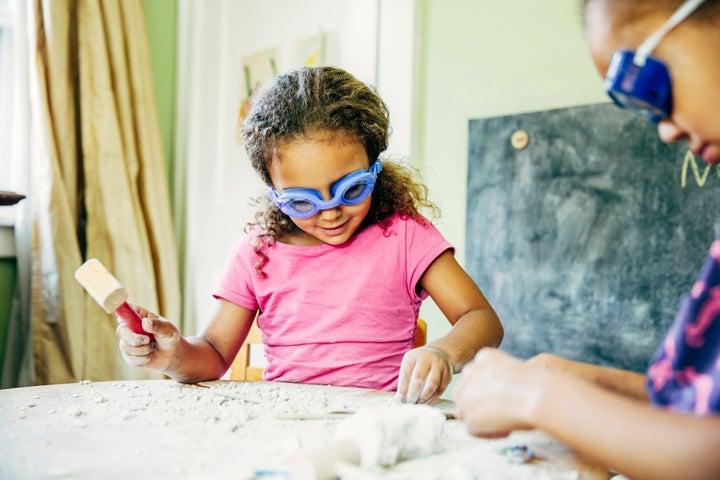
There’s a little girl. Her blue eyes are wide, and she steps up to the microphone.
She’s a five-year-old in front of a room full of adult academics, called up to the front of the room because she wanted so badly to share her dreams with us.
“Um…hi, I want to be a paleontologist,” she says. Her name is Maia Toenjes.
The room of scientists cheers Maia on, asking her questions, treating her like we all wanted to be treated when we were five-year-olds with wide eyes and a deep, deep curiosity about the world.
This was the power of the Women in Paleontology conference.
PaleoFest celebrates rock-digging women who are inspirational scientists
The Burpee Museum of Natural History in urban Rockford, Illinois has put on a paleontology conference every year since 1999.
The event, known as PaleoFest, has a tradition of incorporating a yearly theme. And this year’s theme - Women in Paleontology - served two purposes: to highlight academic research specifically conducted by women paleontologists, and to inspire the public on the nature and need of museums – not to mention the need for events like this one.
From all walks of life, science drives us
A mixture of non-academic paleontology aficionados, paleontology students, and seasoned academics, PaleoFest isn’t your average science conference. No one is given a standard 12-minute time limit to hit the highlights of their work; instead, we have half an hour to gush about how cool our work is, and why it’s relevant.
Talks are presented by scientists at all levels of their careers, from students to founders in the field. The audience is a mixture of young and old, fans and faculty.
It’s a special event, and one thing I heard the speakers and attendees chime in repeatedly was how meaningful and honestly inspiring this meeting was.
Breaking ground in a groundbreaking field
In the earliest days of the Society of Vertebrate Paleontology and other academic paleontological societies, there were few if any women in attendance.
As the 20th Century paved the way for women to become more visible in the sciences, both women and men started to achieve a balanced ratio at these kinds of conferences.
Yet there has never been a meeting like this year’s PaleoFest. Never before has there been a meeting specifically showcasing the work of women in paleontology. And that in itself is groundbreaking.
What do we envision when we think of a “scientist”?
When I was a little kid, I loved science. I think most children do, if for no other reason than we are all born with an innate sense of discovery. But when I teach students, and especially female students, all too often I see one of two things: either students are convinced they aren’t good at science, or they’re convinced science isn’t something they can pursue, because they don’t see people like them in science fields.
Now, this disparity can apply to any traditionally underrepresented group in the sciences, spanning minority groups to LGBTQ visibility and so on. I found it striking, however, that this pervasive feeling of “that can’t be me” was affecting my students’ ability to engage with science as a whole.
That’s why conferences like these, conferences that bring together the work of women in the sciences and display that work to the public in a fresh and engaging way, are so significant.
From dinosaur droppings to the shape of ancient brains
Take some of the topics from the conference, for example. Graduate student Rhiannon LaVine and professor Peg Yacobucci had visitors and academics alike divided into two camps over which animals represented the most charismatic invertebrate fossils – the bug-like trilobites and the spiraled ammonites. You don’t get that at your average TED talk.
Paleontologist ReBecca Hunt-Foster described the conservation efforts at a Bureau of Land Management site, where dinosaur tracks are being preserved for generations to come. Families approached the Burpee Museum’s Science Director, Scott Williams, at a local restaurant and asked, in all seriousness, if the “poop lady” paleontologist had arrived in town – my former adviser, Dr. Karen Chin, a renowned fossil dropping expert. (Our lab had a great sense of humor.)
Paleoneurologist (yes, that’s a thing!) Ashley Morhardt led us through the heart wrenching history of scientist Tilly Edinger; Tilly’s flight from Holocaust-era Germany led her to become one of the founders of the study of ancient animal brains. Jill Scott took us on her journey through the women-dominated workshops to study the structure of Homo naledi, a new branch on the human family tree.
And so it went, with plenty of hands-on activities for kids, behind-the-scenes lab tours for visitors, and a remarkable keynote speech by Egyptian paleontologist Hesham Sallam on his stalwart group of women paleontologist graduate students at Mansoura University.
Not only was PaleoFest entertaining, it may just have sparked the beginning of a coalition of women in STEM with a focus on paleontology. Above all it was great fun to share our thoughts and ideas with colleagues and the public alike.

As paleontologists who once stood in that little girl’s shoes, trying to see ourselves in science, we all left the Women in Paleontology conference with more than just a few business cards and research objectives.
We were, all of us, just like that little girl, once.
We wanted to be paleontologists, too.
You go, girl.
So, you want to be a paleontologist?
Start with the basics. Talk to your local museum. Find a field dig. Keep asking questions – and remember, you’re not alone.
―
Taormina (Tara) is a science teacher and paleontologist at The Webb Schools in southern California. Her research has focused on the paleoecological interpretation of trace fossils in New England and the western United States, including dinosaur tracks and coprolites (fossilized droppings).
Her blog: Outbound Adventurer
